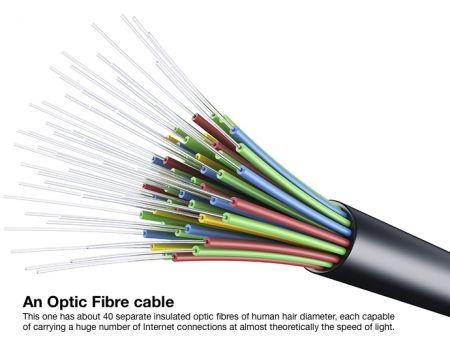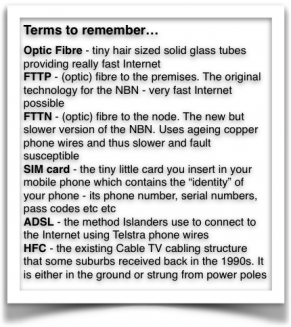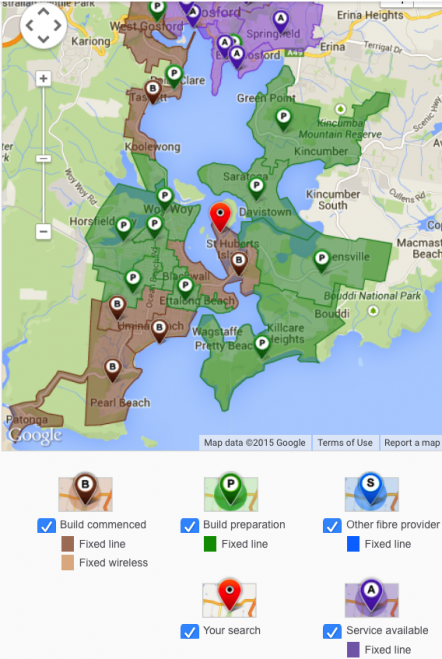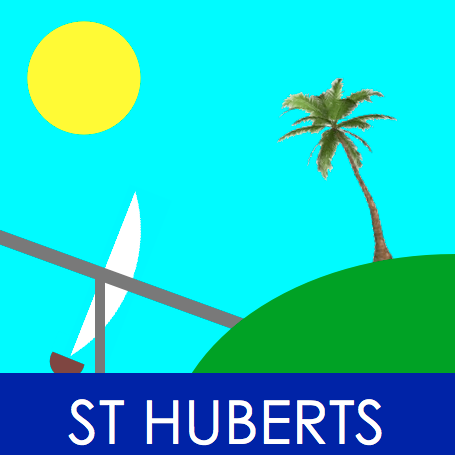NBN Special Report - Part 2
- Part 1 - Confusion, Myths, What will happen
- Part 2 - History, Terminology, NBN on the Peninsula, St Huberts Internet before NBN
- Part 3 - NBN basics for the Island user - when it arrives
- A map of possible St Huberts Internet Speeds
- FTTN cabinets on St Huberts
- NBN Presentation to 2016 March AGM
The National Broadband Network on St Huberts Island - Part 2
In Part 1 you were introduced to the NBN on St Huberts and how it will affect you.
In this part I will investigate a little bit of the history of the NBN - which is pretty much politically driven, a tad about the NBN on the Central Coast and finally a little bit about the Internet access we currently have on the Island.
The “History” of the NBN.
Without getting too political, too carried away because of my technology background, or too longwinded here goes…- In 2003 during the Howard government, their Broadband Advisory Group recommended a “national broadband network”, replacing the “increasingly obsolete” copper phone network with optic fibre or an alternative.
- 2005, and Telstra as owner of this copper network wanted to upgrade their copper using optic fibre. Telstra dropped these plans after the Howard Government (as majority shareholders) were not going to provide additional investment. Other legal hurdles, both regulatory and legal also contributed to its demise.

- 2007 was the election of the Rudd Labor government. One of their policies was the construction of a “super-fast” national broadband network. While the costing of this NBN was to be A$15 billion, the funding of it was a rather convoluted process using the federal government, Telstra, private companies and state governments. The Global Financial Crisis led to major funding problems in 2009. ... And the expected cost of the NBN continued to increase - at one stage up to A$43 billion.
- 2009 saw the release of the final Labor government’s design for the NBN. This included optic fibre to the premises (FTTP), wireless to communities below a certain size (eg Copacabana), and satellite to more isolated areas of the country.
- In 2010 the first (trial) of the NBN in parts of Tasmania using fibre to the premises occurred. The NBN Co continues to rollout fibre to the premises as I type - premises from near the Spike Milligan pedestrian bridge through to West Gosford for example.

- The Abbott Liberal government gained power in 2013. They immediately announced changes to the NBN - particularly making the project cheaper and quicker to complete. The major change was to use existing (ageing) Telstra copper phone wires, and existing cables currently used for pay TV and Internet access in selected built-up areas - typically Telstra, Foxtel and Optus TV cabling. This is called the Hybrid Fibre-Coaxial cable network - HFC, and it is renown for “clogging up/slowing down” when too many people use it for Internet access.
St Huberts will get the NBN version using the ageing, failing, slow Telstra copper wire into our houses. This technology is called Fibre to the Node - FTTN, and will arrive sooner than Rudd's FTTH.
The NBN and The Peninsula.
As many explain, for political reasons, areas around the Central Coast were early recipients of the NBN - and they received the faster and more efficient optic fibre to the premises version of the NBN - FTTP.

The NBN Co map above (as at 10 March 2015) shows area “A” around Gosford, Springfield and Erina that are already connected to the fast FTTP NBN.
Areas “B” from Koolewong/Tascott to West Gosford are currently having their fast FTTP NBN rolled out. You may well see NBN and other contractor vehicles and trucks working on the roads in this area.
The remaining “P” areas around Brisbane Water from Ettalong, across to Pretty Beach and up to Green Point are earmarked for the Abbott government's new and slower version of the NBN - fibre to the node or FTTN which uses our ageing copper phone wires.
However the Island, Umina, Patonga and Pearl Beach are now “B” and construction has started on FTTN - much sooner than the originally planned Rudd FTTP.
By the way… it appears that new housing estates will continue to be hooked up to the NBN using the faster FTTP - trenches still need to be dug and cabling put in whether it is FTTP or FTTN/copper wire.
St Huberts Island’s Internet.
NERD ALERT - this section gets a little technical but hopefully easy to understand…
Currently you are most likely receiving your Internet in one of two ways -
- Via a mobile phone SIM card in a smart phone or similar device, or a SIM card in a small “box of tricks” (aka “black box”) that creates connections between WiFi devices and the Internet. These devices use the familiar 3G and 4G mobile phone towers around the country.
However, Internet speeds using these devices are affected significantly by signal strength, distance from the phone tower, line-of-sight and topography issues, the efficiency of the antenna in your phone etc etc, and the number of phones connected to your current tower. Mobile phone Internet slows down for more connected users. Look what happens in the Sydney CBD during New Years Eve - calls drop out or cannot be made due to mobile phone tower congestion. - ADSL (Asynchronous Digital Subscriber Line) - in other words you connect a box (an ADSL modem) to the copper phone line coming into your house. The copper wires can happily carry Internet and phone through the same pair of wires.
ADSL probably uses a pair of Telstra’s copper wire that runs from the Woy Woy telephone exchange in Macmasters Rd to your house. This distance is about 4.5 to 5.5 km and there are many points in its “trip” where it is cut and reconnected - at pillar boxes and pits in the ground.
Basically the further away from the phone exchange you are, and the more connections your copper phone line pass through, the worse your ADSL Internet is - worse means slower.
Most Internet companies won’t do ADSL more than 3 km from the phone exchange.
My house is 5.5 km from the exchange and I just get ADSL at home. I have done occasional Internet speed tests using speedtest.net which indicate I get a download speed varying from 2.8 to 5.21 Mbps (megabits per second) and an upload speed of around 0.8 Mbps - not very fast, but soon to be eclipsed by the NBN when it arrives on the Island.
Next... in Part 3… what is FTTN all about, internet speeds, and what you get from the NBN Co.
